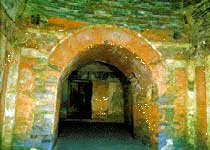Attration Category
Nanjing Weather

After the fall of the Tang dynasty at the end of the 9th century, the area around Nanjing was part of the kingdom of Wu. In 937 Xu Zhigao took control of the area, changed his name to Li Bian and established a dynasty named after the Tang and commonly called the Southern Tang. The empire covered modern day, Jiangsu, Anhui, Jiangxi, Fujian and Hunan provinces, with its capital at Nanjing.
The tomb of Li Bian, who died in 943, and his son Li Jian, who died in 961, are found about ten miles south of Nanjing on the south side of Zutang hill. The third king, Li Yu, was taken captive by the Song emperor to Kaifeng in 974 and died there.
In 1950 a series of ancient artifacts were discovered for sale in Nanjing's antiques markets. Ultimately, they were traced to the tomb of Li Bian, which was unknown prior to this time. The tomb of Li Jian was discovered a short time later. In October 1950, the tombs were excavated under the direction of the Nanjing Museum and many of the artifacts from the tombs are now on display at the Nanjing Provincial Museum on Zhongshan East Road. Unfortunately, most of the objects from the tomb were stolen and never recovered.
The tombs are similar in layout with a series of three chambers, each lined with niches on the east and west. The innermost chamber is where the emperor was laid to rest. The first tomb has better workmanship, including stone bas-reliefs of tomb guardians and dragons. The ceilings and walls of both tombs were originally covered with plaster and painted with murals, but most of this has long since deteriorated away, due to the damp conditions inside.


